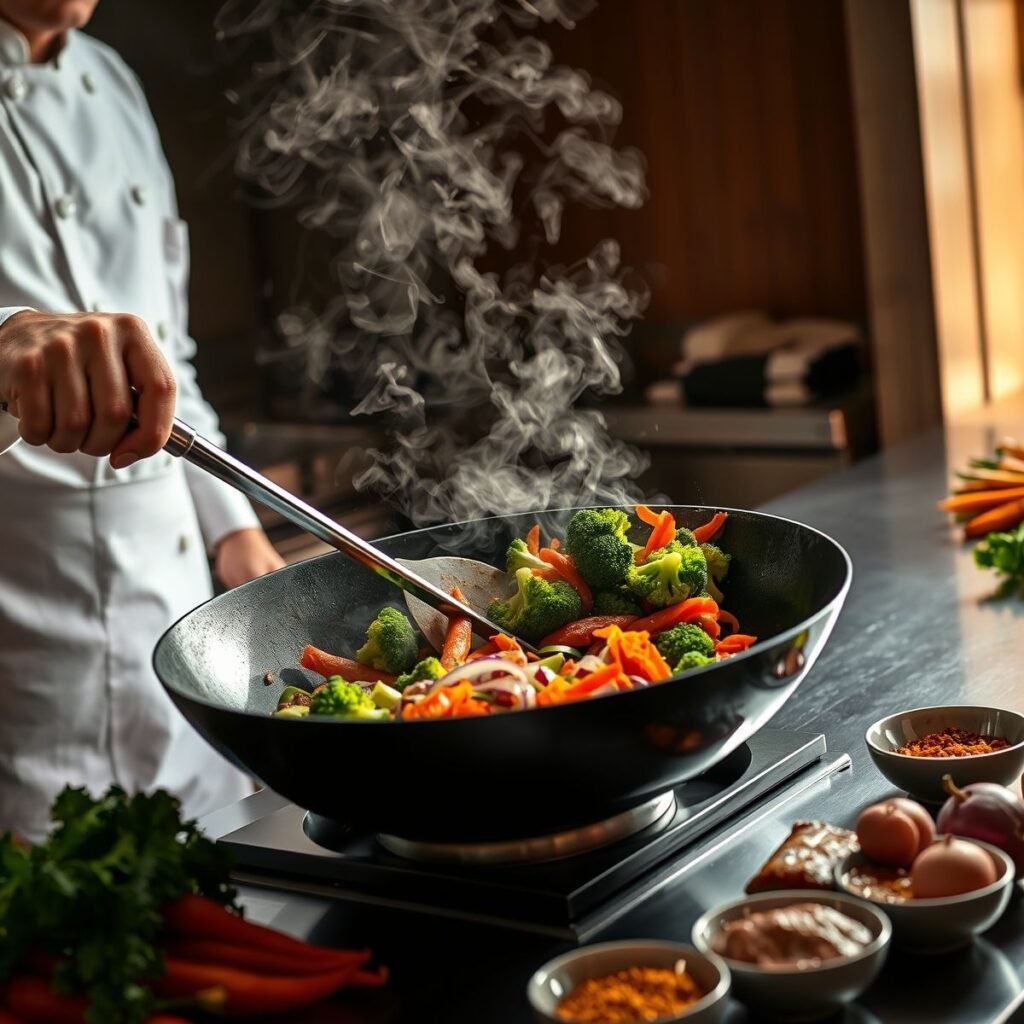Índice do Conteúdo
- Understanding Wok Cooking
- Built for Real Life, Not Fancy Kitchens
- Choosing the Right Ingredients
- Essential Wok Techniques
- The Role of Sauces and Seasonings
- Cooking Times and Temperature Control
- Making It a Complete Meal
- Health Benefits of Stir-Frying
- Common Mistakes to Avoid
- Experimenting with Global Flavors
Understanding Wok Cooking
Wok cooking is an age-old culinary technique that emphasizes high heat and quick cooking. This method, primarily used in Asian cuisines, allows for the rapid stir-frying of ingredients, ensuring that flavors remain vibrant and textures crisp. When it comes to wok recipes for stir-fry success, understanding the nuances of the wok itself—its shape, materials, and how to properly season it—is essential in achieving high-heat dishes bursting with flavor.
Choosing the Right Ingredients
For optimal stir-fry results, selecting the right ingredients is crucial. Fresh vegetables like bell peppers, broccoli, and snap peas not only contribute to the dish’s nutritional value but also add color and crunch. Proteins such as chicken, beef, or tofu should be cut into uniform pieces to ensure even cooking. Additionally, using high-quality oils, such as peanut or sesame oil, can greatly enhance the flavor profile of your wok recipes for stir-fry success.
Essential Wok Techniques
Mastering essential wok techniques is vital for anyone looking to create delicious stir-fry dishes. Start by preheating your wok until it is smoking hot. This high temperature is necessary for achieving that signature sear on your ingredients. Utilize a combination of stirring and tossing to cook the food evenly, while also allowing for the delicious caramelization of flavors. Remember, timing is everything; add ingredients based on their cooking times to ensure everything is perfectly cooked.
The Role of Sauces and Seasonings
Sauces and seasonings play a pivotal role in elevating the flavors of your stir-fry. Commonly used sauces include soy sauce, oyster sauce, and hoisin sauce, each adding a unique depth to your dish. It’s important to balance these sauces with seasoning agents like garlic, ginger, and scallions, which contribute aromatic qualities that enhance the overall taste. Experimenting with different combinations can lead to discovering your signature wok recipes for stir-fry success.
Cooking Times and Temperature Control
Cooking times and temperature control are critical aspects of creating high-heat dishes. Maintain a consistent high temperature to ensure that your vegetables remain crisp and your proteins are cooked thoroughly. Generally, vegetables should be added first, followed by meats, as they require different cooking times. It’s advisable to have all your ingredients prepared and within reach before you begin cooking, enabling you to manage the high-heat process effectively.
Making It a Complete Meal
To create a complete meal using wok recipes, consider incorporating a variety of food groups. Adding a starch, such as rice or noodles, can turn a simple stir-fry into a hearty dish. You can also incorporate a protein source and a medley of colorful vegetables to ensure a balanced meal. This not only enhances the nutritional profile but also makes your dish visually appealing, aligning with the idea of high-heat dishes bursting with flavor.
Health Benefits of Stir-Frying
Stir-frying is not only a quick cooking method but also a healthy one. Cooking at high temperatures for a short amount of time helps retain vitamins and minerals in vegetables, making them more nutritious. Additionally, using minimal oil compared to other cooking methods means fewer calories and fat. This technique is perfect for those looking to enjoy delicious, nutritious meals without compromising on flavor.
Common Mistakes to Avoid
When perfecting your wok recipes for stir-fry success, it’s important to be aware of common mistakes that can hinder your culinary efforts. Avoid overcrowding the wok, as this can lower the cooking temperature and lead to steaming rather than stir-frying. Similarly, be cautious with the amount of sauce used; too much liquid can make your dish soggy. Lastly, ensure your wok is properly seasoned to maximize its non-stick properties and enhance flavor.
Experimenting with Global Flavors
While traditional stir-fry recipes often focus on Asian flavors, don’t be afraid to experiment with global influences. Incorporating spices and ingredients from various cuisines can lead to innovative and exciting dishes. For instance, adding curry powder for an Indian twist or using chimichurri for a South American flair can create a fusion of flavors that keeps your stir-fry repertoire diverse and engaging.



